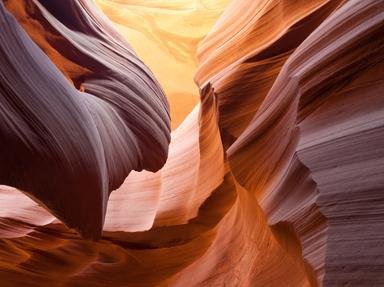Quiz Answer Key and Fun Facts
1. Our story begins a long time ago on a tectonic plate far, far away. Our rock, let's just call him Bob the Basalt, solidifies from basaltic lava pouring out of a volcano at a midoceanic ridge. At the moment of his birth, is Bob a metamorphic rock?
2. Bob the Basalt spends his short happy life as a part of the top layer of the ocean crust. All good things must come to an end, however, and Bob's plate begins subducting beneath another plate, this one made out of continental crust. Bob and all his friends start on their journey into the upper mantle. What kind of rock does Bob become?
3. As Bob goes deeper and deeper into the mantle, he becomes yet another different kind of rock. What rock does Bob-the-former-Basalt turn into at conditions above 500 degrees C and 1.2 gigapascals?
4. Maybe Bob meets his end in the mantle. Maybe Bob bobs up to the surface if the lower, denser part of the plate de-laminates from the downgoing slab and sinks. In any case, let's turn our attention to his sister, Hillary Tuff. Hillary Tuff formed when a volcano in an island chain coughed up a lot of volcanic ash, which settled in a layer on the flank of the volcano. Hillary Tuff has the same bulk composition as Bob the Basalt. When this island chain runs into the continent and things start to heat up just a little bit, what kind of minerals form in Hillary?
5. As the Hillary Tuff formation rams into the continent at full steam, Hillary goes through the mid-T, mid-P greenschist and amphibolite facies. Remember, Hillary has a mafic bulk composition. If Hillary is mostly consists of plagioclase and amphibole in the greenschist facies, what will happen to her in the amphibolite facies?
6. Let's shift our attention from Hillary Tuff to the excitement on the continent that was unlucky enough to run into an island arc. The island arc is pretty well stuck. It's just too darn big and bulky to subduct. The continent ain't moving, either. They're gradually getting smushed together. What sort of geologic event do we have here?
7. A great big wedge of muddy sediment lay of the edge of this continent. We'll call it Pete the Pelite. Pete became several different kinds of rock on his way to fame-- the lower temperature metamorphosed parts of him are now covering the floors and roofs of the homes of the rich and famous. What is the order, from lowest temperature and pressure to highest, of the kinds of rocks that Pete the Pelite became?
8. It just so happens that at the moment, Pete the Pelite is equilibrating to conditions in the lowest temperature portion of the amphibolite facies. Which mineral is just now forming in Pete?
9. Next to Pete the Pelite we have Cici the Siliceous Limestone. Before metamorphism occurred, Cici consisted of calcite with a little bit of quartz. What mineral will most likely form in Cici?
10. Finally, we come to Bryce the Gneiss. Would Bryce be more likely to melt in the presence or absence of water?
Source: Author
pu2-ke-qi-ri
This quiz was reviewed by FunTrivia editor
crisw before going online.
Any errors found in FunTrivia content are routinely corrected through our feedback system.

